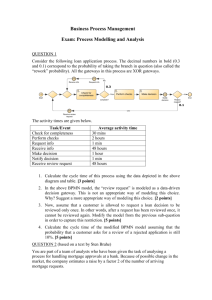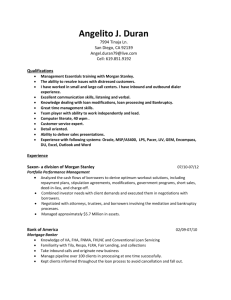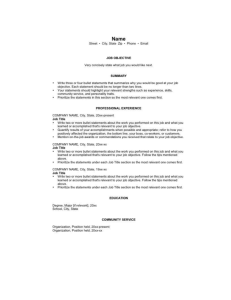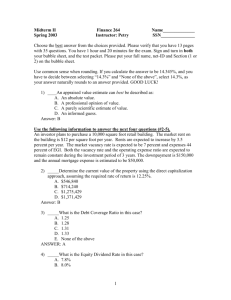Phase 2 Homework Questions
advertisement
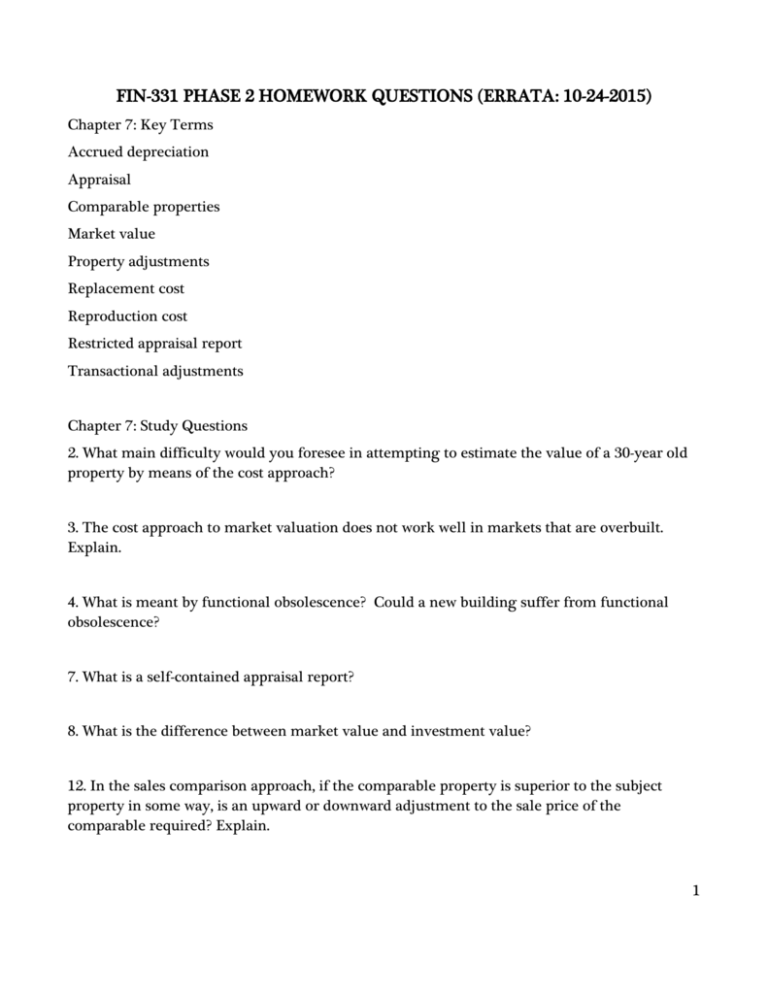
FIN-331 PHASE 2 HOMEWORK QUESTIONS (ERRATA: 10-24-2015) Chapter 7: Key Terms Accrued depreciation Appraisal Comparable properties Market value Property adjustments Replacement cost Reproduction cost Restricted appraisal report Transactional adjustments Chapter 7: Study Questions 2. What main difficulty would you foresee in attempting to estimate the value of a 30-year old property by means of the cost approach? 3. The cost approach to market valuation does not work well in markets that are overbuilt. Explain. 4. What is meant by functional obsolescence? Could a new building suffer from functional obsolescence? 7. What is a self-contained appraisal report? 8. What is the difference between market value and investment value? 12. In the sales comparison approach, if the comparable property is superior to the subject property in some way, is an upward or downward adjustment to the sale price of the comparable required? Explain. 1 Chapter 8: Key Terms Capital Expenditures Direct capitalization Effective gross income Effective gross income multiplier Capitalization rate Natural vacancy rate Net operating income Operating expenses Chapter 8: Study Questions 1. Data for five comparable income properties that sold recently are shown below: Property NOI Sale Price Overall Rate A $ 57,800 $ 566,600 0.1020 B 49,200 496,900 0.0990 C 63,000 630,000 0.1000 D 56,000 538,500 0.1040 E 58,500 600,000 0.0975 What is the indicated overall rate (RO)? 1. Use the following property data: Cash flow from operations: Year NOI 1 2 3 4 5 $150,000 $150,000 $150,000 $150,000 $150,000 Debt Service $125,000 $125,000 $125,000 $125,000 $125,000 Cash Flow at sale: 2 Sale Price: $2,000,000 Cost of sale: $125,000 Mortgage balance: $1,500,000 a. Assuming the going-in capitalization rate is 8.00%, compute a value for the property using direct capitalization. Chapter 8: Study Questions (Continued) 5. Given the following owner’s income and expense estimates for an apartment property, formulate a reconstructed operating statement. The building consists of 10 units that could rent for $550 per month each. Owner’s Annual Income Statement Rental income (last year) $60,600 Less: Operating & capital expenses Power $2,200 Heat 1,700 Janitor 4,600 Water 3,700 Maintenance 4,800 Reserve for capital expenditures 2,800 Management 3,000 Tax depreciation 5,000 Mortgage payments 6,300 Estimating vacancy and collection losses at 5 percent of potential gross income, reconstruct the operating statement to obtain an estimate of NOI. Assume an above-line treatment of CAPX. Remember, there may be items in the owner’s statement that should not be included in the reconstructed operating statement. Using the NOI and a Ro of 11.0%, calculate the property’s indicated market value. Round your answer to the nearest $1,000. 6. You have been asked to estimate the market value of an apartment complex that is producing annual net operating income of $44,500. Four highly similar and competitive apartment properties within two blocks of the subject property have sold in the past three months. All four offer essentially the same amenities and services as the subject. All were open-market transactions with similar terms of sale. All were financed with 30-year fixed-rate 3 mortgages using 70 percent debt and 30 percent equity. The sale prices and estimated firstyear net operating incomes were as follows: Comparable 1: Sale price $500,000; NOI $55,000 Comparable 2: Sale price $420,000; NOI $50,400 Comparable 3: Sale price $475,000; NOI $53,400 Comparable 4: Sale price $600,000; NOI $69,000 What is the indicated value of the subject property using direct capitalization? 8. Describe the conditions under which the use of effective gross income multipliers to value the subject property is appropriate. 4 Chapter 9: Key Terms Adjustable-Rate Mortgage Balloon Loan Contract for Deed Deed of Trust Default Foreclosure LIBOR Negative Amortization Nonrecourse Loans Recourse Loans Short Sale Term to Maturity Chapter 9: Study Questions 1. Mortgage law is as clear, consistent, and enforceable in the United States as in any place in the world, and far more so than in many countries. Why is this a vital element of an efficient real estate finance system? 4. Most lenders making adjustable rate mortgage loans offer a “teaser rate.” Is this a good policy or is it misrepresentation? 6. For your own state, determine whether: a. It is a judicial or non-judicial foreclosure state. b. The standard home loan is based on a deed of trust or a mortgage. c. There is a statutory right of redemption, and, if so, how long. d. Deficiency judgments are allowed against defaulted homeowners. Based on this information can you judge your state is relatively debtor friendly or borrower friendly? 5 Chapter 10: Key Terms Alt-A Loan Conforming Conventional Loan Conventional Mortgage Fannie Mae Freddie Mac FHA GSE Home Equity Loan Jumbo Loans Primary Mortgage Market Secondary Mortgage Market Reverse Mortgage Subprime Loan Chapter 10: Study Questions 1. On an adjustable mortgage, do borrowers always prefer smaller (i.e. tighter) rate caps that limit the amount the contract interest rate can increase in any given year or over the life if the loan? Explain why or why not. 2. Explain the potential tax advantages associated with home equity loans: 3. Distinguish between conforming and nonconforming residential mortgage loans and explain the importance of the difference. 4. Discuss the role and importance of private mortgage insurance in the residential mortgage market. 6. Suppose a homeowner has an existing mortgage loan with these terms: Remaining balance of $150,000, interest rate of 8%, and remaining term of 10 years (monthly payments). This loan can be replaced by a loan at an interest rate of 6 percent, at a cost of 8% of the outstanding loan amount. Should the homeowner refinance? What difference would it make if the homeowner expects to be in the home for only five more years? 6 Chapter 11: Key Terms: Collateral Credit Scoring Disintermediation Housing Expense ratio Interest rate Risk Loan Underwriting Pipeline Risk Qualified Mortgage Total Debt Ratio Study Questions: 1, 2, 4, 9 1. What is the primary purpose of the risk-based capital requirements that Congress enacted as part of the Financial Institutions Reform, Recovery, and Enforcement Act (FIRREA)? 2. Explain what is meant by forward commitments and standby forward commitments. Which part of the mortgage banker’s pipeline is often hedged with forward commitments? With standby forward commitments? Why? 4. Explain the importance of Fannie Mae and Freddie Mac to the housing finance system in the United States. 9. You have just signed a contract to purchase your dream house. The price is $120,000 and you have applied for a $100,000, 30-year, 5.5 percent loan. Annual property taxes are expected to be $2,000. Hazard insurance will cost $400 per year. Your car payment is $400, with 36 months left. Your monthly gross income is $5,000. Calculate: a. The monthly payment of principal and interest (PI). b. One-twelfth of annual property tax payments and hazard insurance payments. c. Monthly PITI (principal, interest, taxes, and insurance). d. The housing expense (front-end) ratio. e. The total obligations (back-end) ratio. 7


